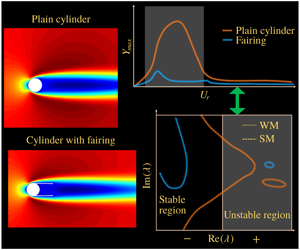Crossref Citations
This article has been cited by the following publications. This list is generated based on data provided by
Crossref.
Chen, Dongyang
Marzocca, Pier
Xiao, Qing
Zhan, Zhihuan
and
Gu, Chaojie
2020.
Vortex-induced vibration on a low mass ratio cylinder with a nonlinear dissipative oscillator at moderate Reynolds number.
Journal of Fluids and Structures,
Vol. 99,
Issue. ,
p.
103160.
Mishra, Alok
and
De, Ashoke
2021.
Suppression of vortex shedding using a slit through the circular cylinder at low Reynolds number.
European Journal of Mechanics - B/Fluids,
Vol. 89,
Issue. ,
p.
349.
Chizfahm, Amir
and
Jaiman, Rajeev
2021.
Data-driven stability analysis and near-wake jet control for the vortex-induced vibration of a sphere.
Physics of Fluids,
Vol. 33,
Issue. 4,
Bukka, Sandeep Reddy
Gupta, Rachit
Magee, Allan Ross
and
Jaiman, Rajeev Kumar
2021.
Assessment of unsteady flow predictions using hybrid deep learning based reduced-order models.
Physics of Fluids,
Vol. 33,
Issue. 1,
Youssef, Mohammed
el Moctar, Ould
el Sheshtawy, Hassan
Tödter, Simon
and
Schellin, Thomas E.
2022.
Passive flow control of vortex-induced vibrations of a low mass ratio circular cylinder oscillating in two degrees-of-freedom.
Ocean Engineering,
Vol. 254,
Issue. ,
p.
111366.
Cheng, Zhi
Lien, Fue-Sang
Dowell, Earl H.
Wang, Ryne
and
Zhang, Ji Hao
2022.
Data-driven stability analysis via the superposition of reduced-order models for the flutter of circular cylinder submerged in three-dimensional spanwise shear inflow at subcritical Reynolds number.
Physics of Fluids,
Vol. 34,
Issue. 12,
Chizfahm, Amir
and
Jaiman, Rajeev
2022.
Deep learning for predicting frequency lock-in of a freely vibrating sphere.
Physics of Fluids,
Vol. 34,
Issue. 12,
Wu, Ying
Cheng, Zhi
McConkey, Ryley
Lien, Fue-Sang
and
Yee, Eugene
2022.
Modelling of Flow-Induced Vibration of Bluff Bodies: A Comprehensive Survey and Future Prospects.
Energies,
Vol. 15,
Issue. 22,
p.
8719.
Luo, Fuqing
Gao, Chuanqiang
and
Zhang, Weiwei
2022.
The key to suppress vortex-induced vibration: Stability of the structural mode.
Journal of Fluids and Structures,
Vol. 113,
Issue. ,
p.
103692.
Cheng, Zhi
Lien, Fue-Sang
Yee, Eugene
and
Zhang, Ji Hao
2022.
Mode transformation and interaction in vortex-induced vibration of laminar flow past a circular cylinder.
Physics of Fluids,
Vol. 34,
Issue. 3,
Zhou, Lei
Zhang, Zhenzhen
Zhang, Bingchao
and
Tse, K. T.
2022.
Receptivity-orientated drag reduction of twin cylinders by steady leading-edge suction control based on adjoint method.
Physics of Fluids,
Vol. 34,
Issue. 12,
Zhou, Lei
Li, Honghai
Tse, Tim K.T.
He, Xuhui
Maceda, Guy Y. Cornejo
and
Zhang, Hongfu
2023.
Sensitivity-aided active control of flow past twin cylinders.
International Journal of Mechanical Sciences,
Vol. 242,
Issue. ,
p.
108013.
Cheng, Zhi
Lien, Fue-Sang
Dowell, Earl H.
Yee, Eugene
Wang, Ryne
and
Zhang, Ji Hao
2023.
Critical effect of fore-aft tapering on galloping triggering for a trapezoidal body.
Journal of Fluid Mechanics,
Vol. 967,
Issue. ,
Hickner, Michelle K.
Fasel, Urban
Nair, Aditya G.
Brunton, Bingni W.
and
Brunton, Steven L.
2023.
Data-Driven Unsteady Aeroelastic Modeling for Control.
AIAA Journal,
Vol. 61,
Issue. 2,
p.
780.
Xie, Wenbin
and
Le, Guigao
2023.
2D Structural Design and Numerical Simulation of a New Type of Fairing.
Journal of Physics: Conference Series,
Vol. 2565,
Issue. 1,
p.
012026.
Cheng, Zhi
Lien, Fue-Sang
Dowell, Earl H.
and
Yee, Eugene
2023.
Triggering of galloping in structures at low Reynolds numbers.
Journal of Fluids and Structures,
Vol. 118,
Issue. ,
p.
103860.
Duranay, Aytekin
2024.
Girdap Kaynaklı Titreşimlerle Tahrik Olan Su Pompası: Türkiye Akarsularında Potansiyel ve Performans Değerlendirmesi.
Turkish Journal of Maritime and Marine Sciences,
Vol. 10,
Issue. 3,
p.
180.
Huang, Dongmei
Yang, Shuguang
Wang, Yue
Yang, Lufeng
Wu, Shuang
and
Liang, Haobo
2024.
Study on the vortex-induced vibration and flow control of ribbed circular cylinder.
Physics of Fluids,
Vol. 36,
Issue. 7,
Jia, Peng
Yao, Shun
Chen, Xi
Zhang, Jiazhen
Ren, Guangxin
Wang, YuJiao
and
Wang, Xiangyu
2024.
Design and tests of a quick disassembly and assembly system for a deep-sea mineral mixed transportation pipeline.
Ships and Offshore Structures,
Vol. 19,
Issue. 6,
p.
729.
Luo, Fuqing
Gao, Chuanqiang
Lyu, Zhen
and
Zhang, Weiwei
2024.
Elimination of lock-in phenomenon in vortex-induced vibration by passive modal control.
Journal of Fluid Mechanics,
Vol. 984,
Issue. ,
